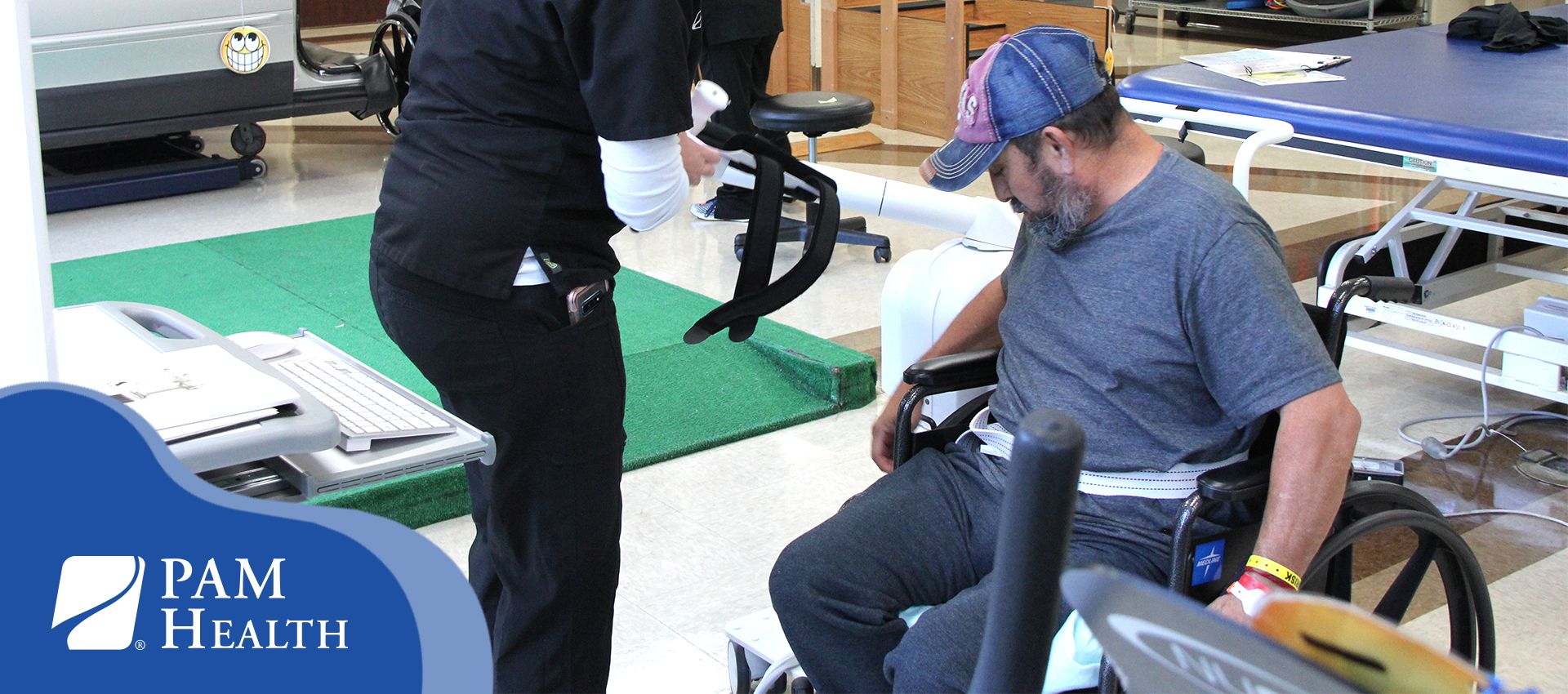
Strike back at stroke – Act fast when stroke happens
May is National Stroke Awareness Month. Know your stroke risk.
Strokes are common and can be deadly. However, the good news is there are things to do to lower the risk for stroke and important things to know should we see someone having a stroke.
Explore Stroke Rehabilitation Programs Offered by PAM Health
May is National Stroke Awareness Month
Strokes are the fifth leading cause of death in the United States and the leading cause of disability in America, according to the American Stroke Association. Stroke survivors can experience physical and emotional changes that impact their quality of life and function.
Awareness and education can save lives. For National Stroke Awareness Month, learn about the types of stroke and how to respond if one happens to someone you love.
What causes a stroke?
A stroke can occur when a blood vessel carrying oxygen and nutrients to the brain is blocked by a clot, bursts, or ruptures for a stroke to happen. This prevents part of the brain from getting the blood and oxygen it needs, and brain cells die.
Types of strokes
The effects of a stroke may vary based on the type, its location, and the amount of damage.
- Ischemic Stroke – when a blood vessel supplying blood to the brain is obstructed. Ischemic strokes account for 87% of all strokes.
- Hemorrhagic Stroke – when a weakened blood vessel ruptures. Aneurysms and arteriovenous malformations (AVMs) are the two types of weakened blood vessels usually causing a hemorrhagic stroke.
- Transient Ischemic Attack (TIA) – a serious, temporary clot. Called a mini-stroke, TIAs are a warning sign of stroke and should be acted upon quickly as the saying goes, “Time is brain!”.
- Brain Stem Stroke – when a stroke occurs in the brain stem. It can affect both sides of the body and may leave survivors unable to speak or move below the neck.
Stroke impact
The severity and impact of the stroke depends upon the section of the brain involved. Some strokes can cause problems with walking, speaking, seeing, or feeling.
According to the American Stroke Association, damage in the left side of the brain can impact the right side of the body. Damage on the left side of the brain may cause:
- speech and language problems
- the inability to read, write and learn new information
- impaired ability to do math or to organize, reason or analyze
If the right side of the brain is affected by stroke, it may impact the left side of the body. Damage may also cause:
- problems with depth perception or directions
- the inability to be creative, such as painting or appreciating art and music
- the inability to recognize emotion in someone’s voice
Recovery and rehabilitation
After a stroke individuals may face physical and mental challenges. Comprehensive inpatient and outpatient therapy such as the types offered by PAM Health hospitals can help patients achieve optimal recovery.
According to a 2017 study of stroke patients, early and intense rehabilitation improved the person’s ability to perform daily tasks.
At PAM Health, we individualize the Stroke Rehabilitation Program to meet the needs of patients and to help them achieve their best quality of life.
Working together, doctors, physical therapists, occupational therapists, speech-language pathologists, and nurses develop a treatment plan to address impairments and patient goals. PAM Health’s stroke recovery program helps patients achieve more positive outcomes than those who do not.
For Sandra Gonzalez, a stroke survivor treated at PAM Rehabilitation Hospital of Clear Lake, a stroke caused neurological deficits and balance issues –– forcing her to use a walker to get around. The PAM Health team helped Sandra regain her balance and so much more. Watch Sandra’s story, here.
Learn More About PAM Health's Rehab Hospital in League City, TX
When a stroke happens, act FAST
Knowing stroke symptoms can help to save a life – including your own. If the F.A.S.T. warning signs are present, call 911.
F = Face drooping
A = Arm weakness
S = Speech difficulty
T = Time (to call 911)
Other stroke symptoms may include:
- Numbness or weakness of the face, arm, or leg
- Confusion
- Trouble seeing
- Trouble walking
- Severe headache
How to prevent a stroke
Several factors can increase a person’s risk for stroke, especially in women.
According to the Centers for Disease Control (CDC), certain types of birth control, pregnancy, and menopause all increase stroke risk.
High blood pressure, also called hypertension, is the biggest risk factor for stroke, according to the American Heart Association. It can damage the circulatory system and significantly contribute to stroke, heart attack, or other health risks. One in three women has high blood pressure and does not know it. Be proactive -- get your blood pressure tested and make lifestyle changes if your blood pressure is high.
Additional risk factors within your control include:
- Smoking
- Diabetes
- Poor diet
- Low physical activity levels
- Obesity
- High cholesterol
Risk factors outside your control include:
- Age
- Family history of stroke
- Race
- Gender
- Prior stroke, TIA, or heart attack
If stroke strikes, turn to PAM Health
If you or someone you care about has experienced a stroke, it’s critical to begin stroke rehabilitation as soon as possible. The sooner rehabilitation begins, the higher the chances of regaining lost abilities or recovering completely.